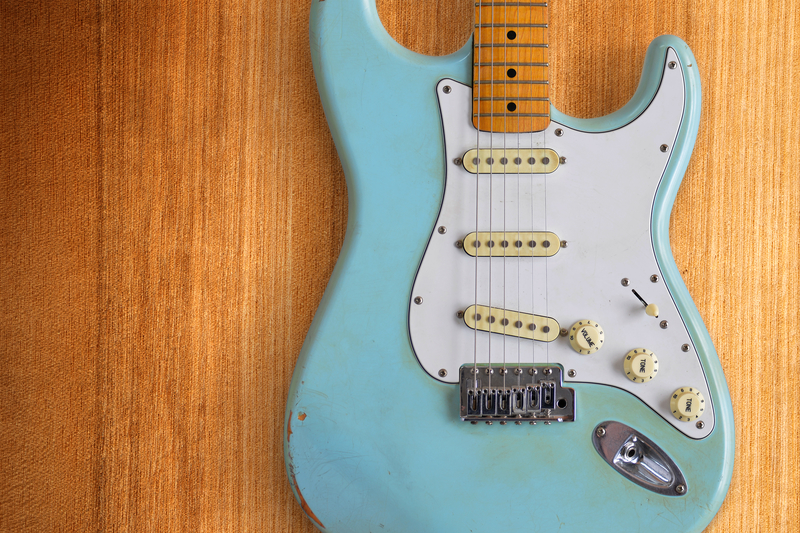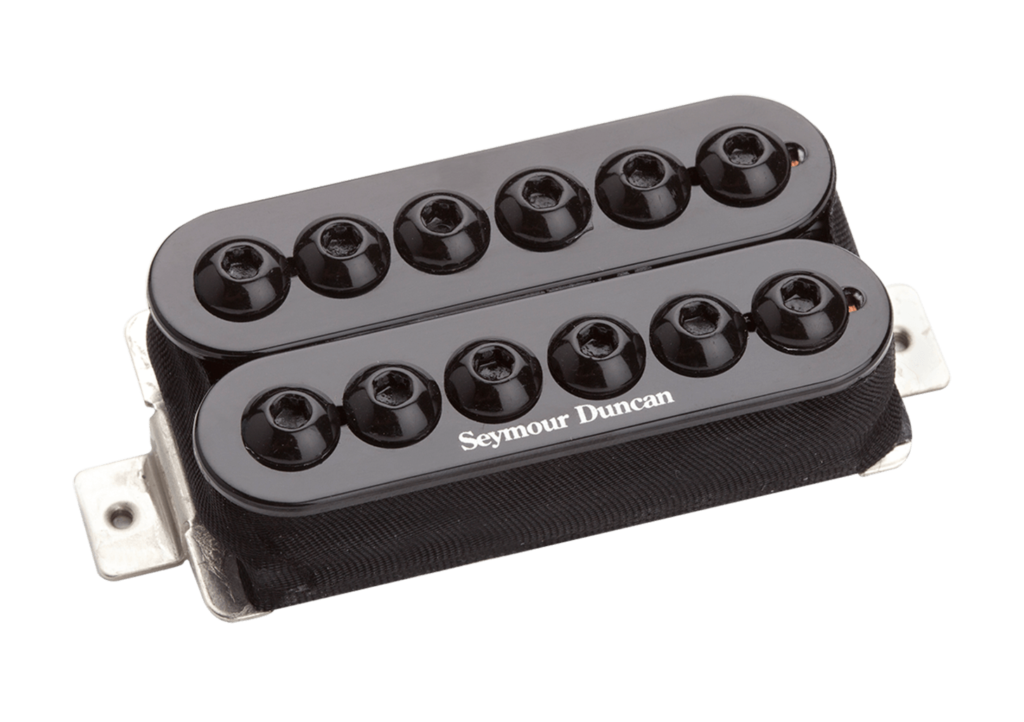The Ultimate Guide to Pickups for Studio Guitars

Becoming more familiar with the colorful world of guitar pickups can help you get better tones in the studio. Here’s what you need to know.
Producers, audio engineers and guitar players all have at least one thing in common: They’re always on a never-ending quest for the perfect tone.
Oftentimes, guitarists try to make changes to their tone by changing strings, trying new amp and cab combos, or adding some pedals to their signal chain.
One thing many of them miss, however, is the pickups.
The pickups in any electric guitar are the foundation upon which the tone is built, meaning they’re arguably one of the most important pieces of your overall tone.
In the studio, your tone is put under a microscope, and every detail matters. And guitar pickups are one pretty major detail.
When I was in the studio recording some of my guitar parts recently, I was playing and wanting to get rid of some annoying overtones.
I spent all of my time trying out different strings, amps, and cabs, but nothing was working. I even tried aging my strings to remove some high-end harmonic content. Crazy, right?
When a mixing engineer helped me identify that my stock EMG pickups could be my problem, finding the tone I was looking for became much easier.
By looking into the gear some of my favorite guitar players use, learning everything I could about how pickups work, and using Seymour Duncan’s pickup selector, I was able to find my dream pickups.
Changing your pickups might be one of the best things you can do for your tone, but it’s important to understand how they affect your tone as a whole so you make the selection that’s right for you.
Even a simple flick of the pickup selector can change your tone dramatically. And in many cases, much of the benefit of swapping out guitars for a part, really comes from the change in pickups. By knowing what to expect from each type of pickup you can get a lot closer to your ideal tone much more quickly.
In this article, we’ll provide an overview of the different types of pickups on the market and give you some ideas on how to choose the pickups that best fit your tonal preferences We’ll also look at how wiring and pickup location affect your tone.
Let’s begin!
Pickup Types
Essentially, a guitar pickup is a magnet wrapped thousands of times by a copper wire coil.
This generates a magnetic field around the strings, which then creates voltage when the string vibrates.
The voltage is what travels out of your guitar, through your pedal chain, and into your guitar amp.
Pickups are the first piece of your tone. The rest of the pieces—your pedals, amp, and cab—are only able to work with the frequencies sent to them by your pickups.
With this in mind, let’s go over the different types of pickups and how they might affect your tone.
Single Coil vs. Humbuckers

Single coil pickups come standard in Fender Stratocasters and Telecasters, among other classic designs, and provide their own distinctive range of tones.
All guitar pickups come in either a single coil or “humbucking” (dual coil) design.
Single coil pickups are commonly associated with the bright, clean tone of Fender Telecasters and Stratocasters, though there are other types of single coil pickups, like P-90s and “lipstick” pickups that may provide a darker, more retro tone.
If you look at the pickups in a Gibson Les Paul, however, those are humbuckers.
The decision to go with single coil or humbucker pickups is entirely subjective. Personally, I usually prefer humbucker pickups for the type of music I play for the following reasons:
- They have stronger output, which can lead to more grit and saturation.
- They have more sustain.
- They usually have less noise.
While these are great features of humbuckers, what really matters is tone. Depending on what you’re playing and the sound you’re looking for, single coil pickups might be the way to go.
Because I tend to like more grit and saturation in my distortion tone, as well as warmer, thicker, clean sounds, humbuckers work well for me in both cases. But studio owners and guitarists looking for more versatility in their arsenal can benefit from having different guitars with each type of pickup, or a studio guitar that has one or more of each type!
Single and dual coil pickups differ in tone in the following ways:
- Single coil pickups are bright and crisp. Humbuckers are warm and dark.
- Single coils usually work better for clean and clear sounds, while humbuckers usually work better with distorted or overdriven tones.
- Single coils have better note definition.
This doesn’t mean, for example, that you can’t get the twangy sound of a single coil if you want to get rid of the hum. Pickups like the Seymour Duncan SVR-1 or the DiMarzio Virtual Vintage are designed in such a way that allows them to maintain a single coil sound, but without the hum.
On the flip side, if you want a clear, twangy clean tone from humbucker pickups, there are some workarounds. You can roll off the volume on your guitar or lower your pickups away from the strings to avoid overdrive, use a bright Fender and turn up the treble, or even install a “coil tap” in your guitar’s circuit to turn your humbucker into a single coil at the flip of a switch.
Active vs. Passive

The Seymour Duncan SH-8B is an exceptionally “hot” humbucker with large magnets and plenty of windings for high gain applications.
The difference between active and passive pickups is simple.
Passive pickups only use magnets, while active pickups use magnets and a battery powered preamp to boost the signal.
While active pickups are mostly found in the form of humbuckers, there are also single coil versions available.
Typically, active pickups will provide you with the following:
- Greater tonal clarity.
- A consistent tone regardless of your volume level.
- Stronger amp overdrive.
- Sharper attack.
- More sustain.
Passive pickups also have a potential problem where the strength of the magnets pulls the strings down toward them, which can bring them out of perfect tune. However, this is usually only a problem if your pickups are very close to the strings, and a skilled guitar tech can work around this problem while setting up your guitar.
Active pickups fix this issue by using weaker magnets and compensating with the preamp.
Many of these features seem like no-brainers in favor of active pickups in theory, but once again, it’s all about the tone you’re looking for.
My experience is that, with active pickups, higher frequencies will become much more accentuated—especially when playing leads—and you won’t have the dynamic variation you would with passive pickups.
Passive pickups also seem to allow more of the natural sonic texture provided by the wood and construction of the guitar to carry over, in my opinion.
High vs. Moderate Output
The output level of a pickup is essentially the strength of the signal it sends out to the amp.
If a guitar feels “weak”, or you find yourself wanting it to feel more reactive to your every move, it could mean the pickups have a lower output level than you might desire.
On the other hand, if the guitar sounds too distorted, sensitive or reactive, it means the pickups have too much output (or as some might say, the pickups are too “hot”).
Usually, active pickups have more output than passive pickups because of the preamp, but you can find very hot passive pickups that are intentionally “overwound”—like the Seymour Duncan Invaders—that can compete with the output of active pickups while providing the benefits of passive ones.
Some guitarists say super hot passive pickups like these are too muddy, but I love them. Particularly for leads. Maybe what some perceive as muddy, I perceive as warmth.
When it comes to passive pickups, you have 3 general options to choose from in terms of output level:
1. Vintage – these pickups are the lowest output of all and are designed to mimic the weak magnets found in old, classic guitars.
2. Moderate output – these give you a cleaner sound with more dynamic range, but it can be harder to get an overdriven sound from your amp.
3. High output – these make it easy to achieve distorted tones by overdriving your amp, but they have less dynamic range than lower output pickups.
Again, the level of output you go with is all determined by your preferences.
Guitarists who play rock and metal often prefer higher output pickups, while those who play in genres where a cleaner tone is desired often prefer moderate output pickups.
Magnet Types
A major factor contributing to the tone and output level of a pickup is the magnet the pickups are built with.
Perhaps the most common magnetic material used in high-quality pickups is something called Alnico—a blend of aluminum, nickel, and cobalt. (Hence the name – “Al-Ni-Co”). This blend is popular because it’s been around for ages and is able to maintain its magnetic properties over very long periods of time.
The most popular types of Alnico in aftermarket guitar pickups are Alnico 2, which is known for being softer and more commonly used to achieve a vintage sound, and Alnico 5, which is used in pickups to achieve a very bold and punchy sound, and is commonly used by guitarists who play multiple genres.
Occasionally, you’ll come across other pickups that use Alnico 8, which is even more bold and punchy than Alnico 5.
Guitarists looking for an even hotter output level than Alnico magnets can offer usually go for pickups with a ceramic magnet. These have a more trebly sound and are common in hard rock and metal genres.
Pickup Wiring
With humbucker pickups, you have some options in terms of how you want to wire them depending on if you want a brighter or warmer tone.
Conventionally, humbuckers are wired in “series”, where each coil adds to the power of the other, giving them their powerful, full-bodied sound.
If you want a brighter sound and are willing to sacrifice your output level, you can use what’s called “parallel” wiring, which eliminates noise while keeping a cleaner sound.
Some guitars are wired to allow for both configurations, letting you get a cleaner, but still noiseless sound out of a humbucking guitar.
Conversely, single coil guitars can even be “hot rodded” to have two or more of their pickups operate together in series at the push of a button, to increase their output.
The concepts of parallel vs series wiring requires some visuals to better understand. Check out the video below to get a better idea of how this works:
If you want to hear an example of how this can affect your tone, check out this video:
Pickup Location
One of the most dramatic changes in tone can come from the position of your pickup.
It can even be argued that the position of the pickup has more of an impact on your tone than the pickup itself.
The way it works is this:
The closer your pickup is to the bridge, the brighter it will be and the less sustain it will have.
As you move your pickup away from the bridge, it will gradually become warmer and have more sustain.
Playing with the combination of pickup type and position can give you a great variety of options.
Your pickup switch can also be used to engage different sets of pickups. For example, if you have a dual humbucker setup, you can have a 3-position switch that engages both pickups when in the middle position to capture the warmer tone of the neck pickup without sacrificing the pick attack created from the trebly tone of the bridge pickup. This is something I like to do during guitar solos.
Some more sophisticated humbucker guitars will have a 5 position switch, giving you two more settings, where the pickups are wired in parallel for a more single-coil-like tone.
Single coil guitars can work in a similar way. The “in between” positions on a Fender Strat or Tele will usually combine two of the pickups in parallel for hum-cancelling operation while maintaining single coil tone.
Summing it Up
Your pickups are one of the most important elements of your guitar tone, and changing them can make a bigger impact than you might initially perceive. If your current guitar just isn’t living up to your standards, sometimes swapping in some alternate aftermarket pickups can dramatically improve its tone. It’s a very cost effective and powerful upgrade.
There’s no single “best” option here. The right pickup for one guitarist or song might not work out for another. Lots of metal guitarists prefer active pickups, but some guitarists (myself included) think passive pickups produce more texture and react better to their playing.
If you run a recording studio and can only have one studio guitar, it can be wise to select one that has more than one pickup type, or that has some more advanced pickup selection options. If you can have two or more studio guitars, it can pay to be sure they have different types of pickups.
Hopefully, this guide has left you better equipped to make pickup choices in the studio and has encouraged you to explore the option of upgrading your guitar’s pickups for your next tonal upgrade.
Nick Rubright is a guitarist and the digital marketing specialist at mixandmastermysong.com, an online mixing and mastering service run by award-winning engineer Matty Harris.
Please note: When you buy products through links on this page, we may earn an affiliate commission.






